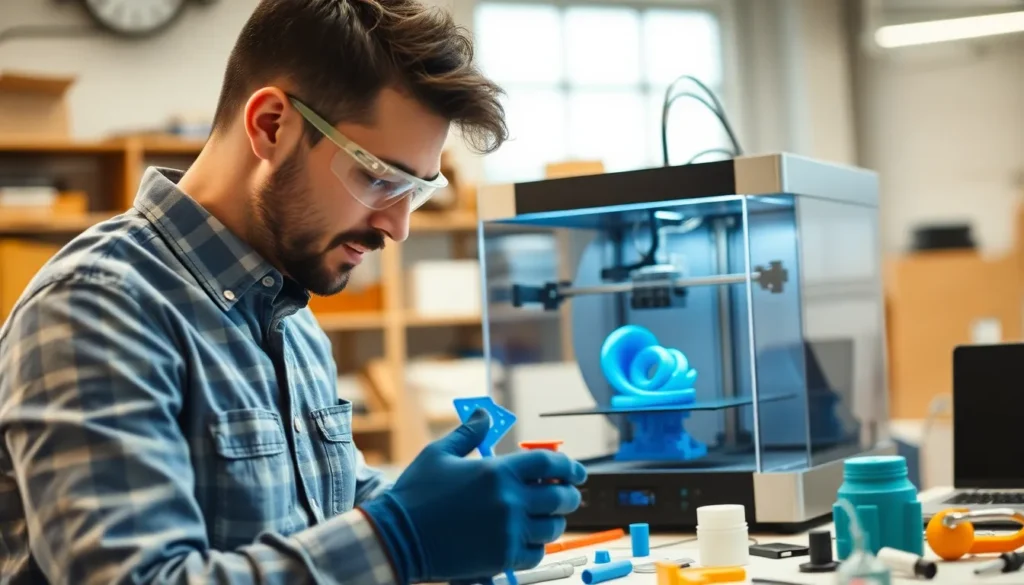Table of Contents
ToggleIn a world where plastic seems to be the reigning champion of materials, sustainable 3D printing is stepping up to the plate like a superhero in a cape made of recycled filament. Picture this: a technology that not only creates jaw-dropping designs but also gives Mother Earth a much-needed hug. It’s like getting the best of both worlds—innovation and eco-friendliness—without compromising on style.
As industries scramble to go green, sustainable 3D printing is leading the charge, transforming everything from prototyping to production. With a sprinkle of creativity and a dash of responsibility, it’s reshaping how we think about manufacturing. So buckle up, because the future of 3D printing isn’t just about what you can create; it’s about how you can do it while keeping the planet smiling.
Overview of Sustainable 3D Printing
Sustainable 3D printing represents a significant advancement in manufacturing technology. This process minimizes waste by using resources efficiently and encourages the recycling of materials. Companies increasingly adopt biodegradable filaments, made from renewable sources, to reduce plastic pollution.
Environmental benefits arise through reduced energy consumption compared to traditional methods. 3D printing often requires less material, addressing the issues surrounding overproduction common in conventional manufacturing practices. For instance, custom parts can be produced on-demand, limiting the need for inventory.
Technological innovations drive sustainable practices in various industries. Across sectors like automotive, aerospace, and construction, sustainable 3D printing fosters both creativity and efficiency. Many organizations utilize this technology to create prototypes and final products that align with eco-friendly principles.
Collaboration among researchers, manufacturers, and environmental organizations promotes advancements in sustainable materials. Research efforts focus on improving the properties of recycled plastics, ensuring they meet performance standards. Significant projects showcase how sustainable 3D printing can lead to reduced carbon footprints in product lines.
Consumer awareness of sustainability increases, influencing market trends. People prioritize eco-friendly products, prompting companies to adopt green manufacturing solutions. Sustainable 3D printing aligns with these consumer demands, providing a path to manufacture items that resonate with environmentally conscious values.
As this technology evolves, its impact on sustainable practices will likely expand. Innovations in materials, techniques, and applications hold the promise of further revolutionizing industries while preserving environmental integrity. Engaging with sustainable 3D printing today sets the stage for a more responsible manufacturing future.
Benefits of Sustainable 3D Printing
Sustainable 3D printing offers significant advantages that impact both the environment and the economy.
Environmental Impact
Sustainable 3D printing notably reduces waste by using materials more efficiently. By minimizing overproduction, this technology allows manufacturers to create items only when needed, cutting excess output. Using biodegradable filaments made from renewable sources lessens dependence on traditional plastics. Companies also prioritize recycling, frequently incorporating recycled plastics into their production processes. Notably, energy consumption decreases compared to conventional manufacturing methods, contributing to a smaller carbon footprint. This shift toward eco-friendly practices supports global efforts to combat pollution and resource depletion.
Economic Advantages
Sustainable 3D printing brings several economic benefits, appealing to businesses aiming to reduce costs. Companies experience lower material waste, directly decreasing production expenses. Custom on-demand manufacturing also enables firms to avoid excess inventory, minimizing storage costs. Investment in sustainable technologies can enhance a company’s brand image, attracting eco-conscious consumers. Additionally, collaboration with researchers fosters innovation in materials, leading to new product opportunities. Adopting green practices aligns with market trends, ensuring competitiveness in an increasingly environmentally focused landscape.
Key Materials for Sustainable 3D Printing
Sustainable 3D printing relies on innovative materials that promote environmental responsibility.
Biodegradable Plastics
Biodegradable plastics represent a significant advancement in sustainable 3D printing. Derived from renewable resources like cornstarch or sugarcane, these materials decompose naturally over time. Features such as reduced environmental impact attract manufacturers seeking eco-friendly options. Companies often use polylactic acid (PLA), a common biodegradable plastic, for its impressive printability and strength. When discarded, PLA breaks down into non-toxic components, contributing to a cleaner planet. As demand for sustainable products increases, the popularity of biodegradable plastics continues to rise.
Recycled Materials
Recycled materials play a crucial role in promoting sustainability in 3D printing. Using filaments made from post-consumer waste reduces reliance on virgin resources. Recycled polycarbonate and PETG are popular choices, offering durable properties without the environmental burden. Many manufacturers invest in recycling technologies to turn waste into usable printing materials. Benefits include less material waste and decreased energy consumption during production. As more industries adopt recycled materials, the circular economy grows stronger, supporting sustainable practices across sectors.
Techniques and Technologies
Sustainable 3D printing employs various techniques and technologies that enhance efficiency while minimizing environmental impact.
Energy Efficiency in 3D Printing
Energy consumption significantly decreases with advancements in 3D printing technologies. Techniques like fused deposition modeling (FDM) and selective laser sintering (SLS) utilize less energy compared to traditional manufacturing methods. Automation in 3D printing processes also cuts down energy usage through optimized machine operation. Innovative power management systems track energy consumption, allowing for further reductions. Some machines incorporate renewable energy sources, adding to their sustainability. Overall, energy-efficient practices not only lower operational costs but also contribute to a smaller carbon footprint.
Innovations in Sustainable Practices
Recent innovations in sustainable practices shape the future of 3D printing. Development of bio-based and recycled filaments provides alternatives to conventional plastics. Companies are experimenting with materials derived from agricultural by-products or industrial waste, promoting a circular economy. Advanced software allows for optimized designs that minimize material usage while maintaining product integrity. Collaboration between manufacturers and material scientists drives breakthroughs in mechanical properties of sustainable materials. These advancements enable 3D printing to meet environmental standards while satisfying market demand for eco-friendly products.
Challenges and Limitations
Sustainable 3D printing faces several challenges and limitations that impact its widespread adoption and effectiveness.
Material Availability
Material availability poses a significant challenge in sustainable 3D printing. Specific biodegradable and recycled filaments often lack widespread access, making sourcing difficult for manufacturers. Traditional materials dominate the market, creating a reliance that hinders the shift to eco-friendly options. Companies may struggle to find high-quality alternatives that meet performance standards. This gap can slow the adoption of sustainable practices, as many businesses need consistent access to materials. Market demand continues to grow, yet suppliers must expand their offerings to accommodate this shift.
Cost Considerations
Cost considerations remain a barrier to the broader implementation of sustainable 3D printing techniques. While these technologies can lower production costs over time, initial investments often deter companies from making the transition. Bio-based and recycled materials typically cost more than conventional plastics, impacting overall product pricing. Smaller companies may struggle to absorb these expenses, making it harder for them to compete. Production processes that incorporate sustainability may also require more advanced technology, further driving up costs. Manufacturers must balance these expenses against the potential long-term benefits of adopting sustainable practices.
Future of Sustainable 3D Printing
Sustainable 3D printing continues to evolve, driving significant industry advancements. This evolution reflects shifts in material usage, technology, and consumer preference towards eco-friendly practices.
Industry Trends
Emerging trends in sustainable 3D printing focus on the adoption of eco-friendly materials and methods. Companies increasingly prioritize biodegradable and recycled plastics, pushing traditional materials aside. Innovations in design software enable more efficient use of materials, lowering waste during production. Industries such as healthcare, automotive, and consumer goods embrace sustainable practices to enhance their brand image and meet market demand. Simultaneously, the integration of sustainable policies into business frameworks fosters a competitive advantage in environmentally conscious markets. As these trends gain momentum, collaboration among various stakeholders becomes vital for success.
Research and Development
Research and development play a crucial role in advancing sustainable 3D printing techniques. Scientists study the properties of bio-based materials, seeking to improve their performance and accessibility. Ongoing efforts aim to make recycled filaments more viable for large-scale production while reducing overall costs. Universities and companies partner to explore innovative solutions that enhance energy efficiency and material recycling processes. Breakthroughs in this space often stem from interdisciplinary cooperation, blending knowledge from materials science, engineering, and environmental science. As these discoveries materialize, they pave the way for more sustainable practices across all sectors involved in 3D printing.
Conclusion
Sustainable 3D printing stands at the forefront of innovation and environmental stewardship. As industries embrace eco-friendly practices, the potential for creativity and efficiency grows exponentially. By minimizing waste and promoting the use of biodegradable and recycled materials, this technology not only addresses pressing environmental concerns but also reshapes manufacturing processes.
The ongoing collaboration among researchers and manufacturers is crucial for overcoming current challenges. As advancements continue to emerge, the future of sustainable 3D printing looks promising. Companies that prioritize sustainability are likely to enhance their competitiveness while contributing positively to the planet. Ultimately, the fusion of creativity and responsibility in 3D printing is paving the way for a more sustainable future.




